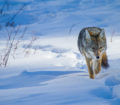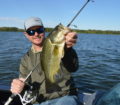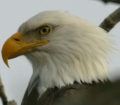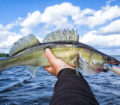By Steve Weisman
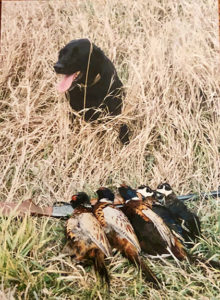
(photo by Steve Weisman) Mandy after a morning’s work of wood duck hunting and pheasant hunting.
One of the most enjoyable parts of hunting pheasants is hunting with a good hunting dog. Without one, it’s like trying to find the proverbial “needle in a haystack,” especially when hunting some of the massive public hunting areas around here. Filled with lots of good habitat, I’ve often wondered, “Why would a pheasant ever fly with only a two-footed human being who, compared to a good hunting dog, has poor eyesight, hearing and sense of smell. A wily rooster can literally run rings around a human being and never be in any danger.
It’s a different deal, though, when the rooster is faced with a well-trained hunting dog. I know this is old hat to many of you, but I also know there are hunters out there who have never had a hunting dog or are weighing the options on whether to make the leap or not. From my perspective, I’ve hunted both ways (with and without a dog) and there’s no comparison.
Watching a good hunting dog unravel the trail of a pheasant is one of the greatest hunting thrills I have ever experienced. When the dog catches the scent of a pheasant, its nose goes down, its tail starts wagging madly and the chase is on. Straight ahead, sharp left, sharp right, straight back, in a circle, back and forth, forward and backward, over and over again…this will go on until the bird races far ahead and takes flight, tries to slip behind and takes flight or finally is chased into a corner where it sits hoping the dog will go by it. If the dog holds true to the scent, the chase ends in flight and the hunter has a good chance of bagging a wily rooster or watching a hen safely fly away.
As I think about the previous scene, it’s pretty obvious that this search, track and flush is the dog’s game. It is what it has been bred to do. As hunters, it is our job to train and refine those basic instincts so that the dog doesn’t take off on a dead run and leave the hunter far, far behind. Patience must be learned, or the hunter becomes frustrated with wild out-of-range flushes. Taught in a consistent, yet patient way from the time the dog is a tiny puppy, a strong bond develops between dog and hunter. Soon, it becomes a team effort with hunter praising the dog for its close flush and the dog proudly returning the downed rooster to the hunter.
I’ve been part of this scene over and over as I reflect on the three hunting dogs, I have been lucky enough to own: a German shorthair, a black lab and a yellow lab. All three are up there in my mental hall of fame. Any shortcomings they possessed were actually my own shortcomings when it came to training them. The best part, though, was they were still mine and we bonded well together.
When my yellow died a few years ago, I chose not to get another hunting dog. It was the right thing to do because of the travel my wife and I do, and – don’t kid yourself – owning a hunting dog (any dog for that matter) is work and it ties a person down. Plus, at age 71, I simply cannot hunt the way I used to. I tire more easily, and it’s not fair to the hunting dog. So, now I hunt with other hunters who have a hunting dog. Maybe it’s an excuse, but that’s the way it is.
For those thinking about making that initial jump into hunting dog ownership, do some research. Find the breed of hunting dog that meets your needs. Then once that choice is made, find a reputable breeder. Visit the breeder, look at the bloodlines and pedigrees and see what the litters look like and how they act and interact with other dogs and humans. Then, it becomes you and your family’s choice…and the journey of “firsts” together is on! And what a journey it will be…from playful puppy mastering the commands of sit-stay-come, to learning what a wing is all about, to retrieving. Of course, there will be the terrible two’s and chewing up some house stuff. I remember when my German shorthair plucked the petals off the bouquet of roses from our wedding! Thankfully, my wife is probably more of a dog love than I am. That’s just the nature of how things go.
I must share what I did with my black Lab Mandy. She was a couple years old, when my two children, Stephanie and Curt were 12 and 10 years old, respectively. They were both pitchers, but to protect the windows and the grass, I had them pitch to me in the street. Of course, in my late 30s, I was not going to crouch in the catcher’s position for an extended period. So, I sat on a five-gallon bucket. If their pitches were within my reach as I sat on the bucket, we were good. If too high, too wide or too low, the ball went to the end of the block.
They didn’t appreciate chasing down the ball and didn’t want to retrieve for each other, so we got Mandy out. She knew her commands very well: sit, stay, fetch and come, both by voice and whistle. So, they had her sit in the driveway and watch. I gave her the command to sit and there she sat following the path of the ball from them to me and back to them over and over. Then came the errant pitch. Mandy watched it bound down the street and wanted to get that ball so very, very badly. However, I held her with the command-sit/stay until the ball hit the curb at the end of the block about 100 yards away. Then I would say, “Mandy, fetch!” It was like she was shot out of a cannon. She was so excited and equally proud to bring back that softball or baseball to hand. I’d say, “Take it to Steph or Take it to Curt.” Of course, it was a little bit slippery with Mandy drool, so Steph and Curt used a big towel to dry off the ball.
Mandy was a great waterfowl retriever, but her real game was figuring out a pheasant trail. It was truly her life, and it gave her great satisfaction to solve the puzzle and flush the pheasant. If it turned out to be a hen and there was no shot, she’d look back at me, “Like really?” If it turned out to be a rooster and I missed, it was, “Like REALLY!” A downed bird and she was gone and soon returning back to me proudly carrying the bird.
Should you get a hunting dog? It’s your choice, and I’m not here to tell you what decision you should make. However, I do know if I were 10 years younger, I’d have another lab pup in training!

